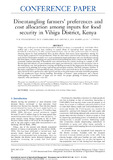| dc.contributor.author | Nyangweso, P. M. | |
| dc.contributor.author | Odhiambo, M. O. | |
| dc.contributor.author | Odunga, P. O. | |
| dc.contributor.author | Korir, M. K. | |
| dc.contributor.author | Otieno, Dennis | |
| dc.date.accessioned | 2021-07-06T13:50:14Z | |
| dc.date.available | 2021-07-06T13:50:14Z | |
| dc.date.issued | 2011-03 | |
| dc.identifier.citation | 18th International Farm Management Association Congress, Thriving In A Global World – Innovation, Co-Operation And Leadership, at Methven, Canterbury, New Zealand, 20 – 25 March 2011 | en_US |
| dc.identifier.uri | https://ideas.repec.org/a/ags/ijameu/149781.html | |
| dc.identifier.uri | https://www.semanticscholar.org/paper/Disentangling-farmers%E2%80%99-preferences-and-cost-among-Nyangweso-Odhiambo/e078e03a41aa97d47b645cfcd8a54f8bb57d8e19 | |
| dc.identifier.uri | https://businessdocbox.com/Agriculture/89188910-Disentangling-farmers-preferences-and-cost-allocation-among-inputs-for-food-security-in-vihiga-district-kenya.html | |
| dc.identifier.uri | http://hdl.handle.net/123456789/4712 | |
| dc.description.abstract | Vihiga, one of the poorest and densely populated districts in Kenya, is perpetually in food deficit. Poor welfare and a low resource base continue to curtail efforts to circumvent food insecurity among households in the district. In their current financial status, what are their preferences when it comes to choosing inputs for food production? How do they allocate their scarce input expenditure among the various inputs required for food production? What are their major considerations when they are making such choices? Descriptive statistics were used to determine input preferences and cost distribution among the farm inputs. Cluster sampling was used with divisions forming the main clusters in the district. Using systematic random sampling, 50 households were selected from each cluster resulting in a sample of 300. Results show that labour cost pre-dominates farm input cost followed by fertilizers and seed maize. Out of the total labour cost, land preparation, weeding and shelling account for the largest part, the balance being accounted for by planting, harvesting, topdressing and transport activities. Similarly, inorganic fertilizer is the major contributor to soil amendment costs, and local seed is preferred due to its low acquisition costs, while hybrid H 614 is preferred to other hybrid seed due to its performance and other desirable properties like low postharvest losses during handling. Knowledge of farmers’ input preferences and a deeper understanding of contributors to input cost are critical for proper planning of farmers production, especially when production is rain fed. | en_US |
| dc.language.iso | en | en_US |
| dc.subject | Farmers’ preferences; cost allocation; Food security; Vihiga; Kenya | en_US |
| dc.title | Disentangling farmers’ preferences and cost allocation among inputs for food security in Vihiga District, Kenya | en_US |
| dc.type | Article | en_US |

